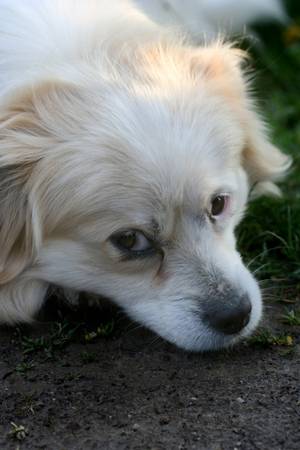Smelly Dogs: Dealing With Pet Odor

Dogs don't smell the same as we do... which is not surprising. But some doggy odors can be unbearable!
If your dogs smells, the first thing to check is where the smell is coming from. Is it the skin, or somewhere else? Odors can emanate from many body parts, including:
- the mouth, which could mean dental problems, digestive problems or underlying internal diseases, such as kidney problems or diabetes.
- the ears, which could mean an ear infection, especially if accompanied by head shaking, pawing at the ears or rubbing them on the ground.
- the backside, which could indicate an anal gland problem or flatulence caused by digestive problems. Some long-haired breeds may have soiling due to feces sticking to the long hair in the area around the anus.
Once you have determined that the smell is in fact from the skin, the solution can be determined more easily. Could the dog have been sprayed by a skunk? Alternatively, many dogs have a habit of rolling in the most revolting places (eg: feces, dead animals), all of which smell awful. Preventing this by bathing the dog, then walking it on a leash in future, are the best methods of combating this problem. Pick up any feces in the yard as quickly as possible to remove any temptation.
|
"Many dogs have a habit of rolling in the most revolting places (feces, dead animals), all of which smell
awful."
|
Dogs have a self-cleaning mechanism in their coats in which dirt, bugs and skin flakes are carried up along the hair shaft to the end, where they fall off. To keep the hair adequately slippery to ensure the dander is carried easily, the dog has glands in its skin which produce sebum, an oily substance which helps lubricate, waterproof and protect.
However, sometimes this mechanism breaks down, most commonly when there is an underlying skin disease such as infection or an allergy. Take a look through your dog's coat to the skin. Are there flakes of skin present (doggy dandruff)? Is it very oily, waxy or sticky? Is it red and inflamed? Is the skin raw underneath? Are there pimples or blisters present? If the answer to any of these is yes, it is likely your dog has a skin disease.
|
Anti-odor treatments
|
Petshed's solutions for geting rid of the whiff from your woofer
|
A visit to your veterinarian may be in order to diagnose the problem so an appropriate treatment can be recommended. This may involve shampooing, in addition to other treatments for allergies or infections.
Flaky or very waxy skin is often associated with a condition called seborrhea. Shampoos are available containing sulfur or selenium sulfide which can help to alleviate the dandruff. As these conditions are often secondary to allergies, shampoos containing oatmeal or aloe vera can help to soothe the skin and reduce the inflammation.
If a secondary bacterial or fungal infection is present, shampoos containing ingredients such as chlorhexidine, tea tree oil, ketoconazole or miconazole may be warranted to clear the underlying infection.
|
"Human shampoos can irritate dog skin by being too acidic. Look for soap-free or hypoallergenic shampoos for
dogs."
|
A good all-purpose shampoo for dogs should be one which is designed for canines, not humans, as the skin pH levels are different. Human shampoos can irritate dog skin by being too acidic. Look for soap-free or hypoallergenic shampoos for dogs. Most shampoos need to be left on the skin for five to 10 minutes before being thoroughly rinsed off. Any shampoo residue can become itchy or sticky and cause the coat to look dull when it dries. Follow with a conditioner if desired.
If you can't face the thought of a bath, there are also dry shampoos available. Both powders and sprays can be applied, then brushed through the coat to clean and deodorize.
And if all else fails, what about a doggy cologne? These can help to keep a smooth, shiny coat in addition to removing the smell. Do be careful, however, about masking the smell if there is underlying disease. If the skin does not look healthy, a visit to your vet is probably warranted.